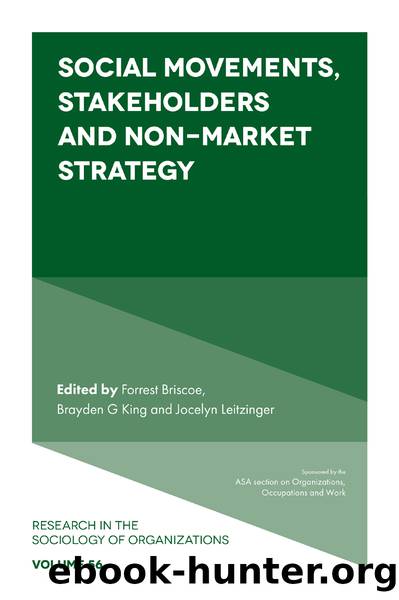Social Movements, Stakeholders and Non-Market Strategy by Briscoe Forrest;King Brayden;Leitzinger Jocelyn;

Author:Briscoe, Forrest;King, Brayden;Leitzinger, Jocelyn;
Language: eng
Format: epub
Publisher: Emerald Publishing Limited
Published: 2018-07-13T00:00:00+00:00
Mobilizing Cultures: Emphasis on Popular Education and Their Social and Political Rights
In the early 20th century, the first labor colleges were formed with a strong left-wing, political orientation and with the aim of building a working-class consciousness among the workers. Because of their political agenda, they were regarded as too radical by the AFL leadership and after World War II these educational programs focused much more on union-specific issues rather than broader politics. While during the 1970s and 1980s there was a continual decline in workersâ education, at the same time, antiwar, civil rights, and womenâs rights activists entered the labor movement, many whom had experiences with popular education in Latin America. Since the 1990s, there have been various initiatives in workersâ education with some unions considering education as a service to members, while others using it as a strategic lever to build the future of a movement (Tarlau, 2011).
The CLEAN carwash campaign is not only important as an innovative model for organizing labor but also because it incorporates the worker centersâ emphasis on immigrant workersâ social and political necessities. While organizing to achieve economic rights, carwash workers claim rights as immigrant workers, and in doing so challenge various forms of exploitation (Roca-Servat, 2011, p. 2). There are many ways this campaign mobilizes cultural elements to produce solidarity and spur collective action.
One of such elements are discursive frames of action stemming from the immigrant rights movement. The carwash worker movement acts as a site of resistance to cultural and social constructions of social and political inequalities. Inside the social inequality spectrum, carwash workers challenge racial, gender, as well as class oppression. With general slogans like âJoin the movement for racial equity and social justice in Los Angelesâ and more specific ones like âEqual pay for allâ and âStop employment discriminationâ carwash workers draw connections between racism, sexism, and classicism. On the side of political inequality, with messages like âNo one is illegal! Amnesty Now!,â âInternational Workers say 2 million too many. Stop the deportations,â and âWorkers coming out of the shadows. Sin Papeles, Sin Miedo,â they confront the political membership status defined by national citizenship. One key difference was thus the adoption of a social justice discursive framing to mobilize the carwash workers rather than focusing solely on economic justice (Roca-Servat, 2011, p. 12).
Another cultural dimension of the campaign has to do with its emphasis on popular pedagogy (Freire, 1970). As such, they worked around the idea of forming community leaders and liberating the âoppressed.â Oppression was understood in a holistic sense to include cultural, social, and political oppression in addition to economic oppression (Roca-Servat, 2011, p. 12). With the help of the Instituto de Educacion Popular del Sur de California (IDEPSCA), campaign organizers used popular education methods to empower immigrant day laborers. In this regard, the use of and emphasis on critical pedagogy as an organizing tool clearly differed from a traditional union organizing campaign.
A broader understanding of oppression opened the discursive framing under which the struggle of carwash workers was constructed.
Download
This site does not store any files on its server. We only index and link to content provided by other sites. Please contact the content providers to delete copyright contents if any and email us, we'll remove relevant links or contents immediately.
Bad Blood by John Carreyrou(5780)
Principles: Life and Work by Ray Dalio(5333)
Rich Dad Poor Dad by Robert T. Kiyosaki(5162)
Management Strategies for the Cloud Revolution: How Cloud Computing Is Transforming Business and Why You Can't Afford to Be Left Behind by Charles Babcock(4135)
The Confidence Code by Katty Kay(3575)
Thinking in Bets by Annie Duke(3540)
Playing to Win_ How Strategy Really Works by A.G. Lafley & Roger L. Martin(3018)
American Kingpin by Nick Bilton(2983)
Delivering Happiness by Tony Hsieh(2926)
Project Animal Farm: An Accidental Journey into the Secret World of Farming and the Truth About Our Food by Sonia Faruqi(2667)
Brotopia by Emily Chang(2594)
I Live in the Future & Here's How It Works by Nick Bilton(2531)
Mastering Bitcoin: Programming the Open Blockchain by Andreas M. Antonopoulos(2517)
The Power of Habit by Charles Duhigg(2497)
The Content Trap by Bharat Anand(2496)
The Marketing Plan Handbook: Develop Big-Picture Marketing Plans for Pennies on the Dollar by Robert W. Bly(2420)
The Tyranny of Metrics by Jerry Z. Muller(2406)
Building a StoryBrand by Donald Miller(2368)
Applied Empathy by Michael Ventura(2334)
